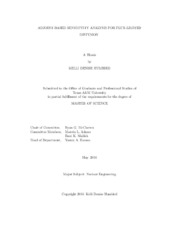| dc.description.abstract | Uncertainty quantification and sensitivity analysis (UQSA) is becoming an essential component for engineering and physics modeling. The growth of UQSA can be attributed to improved statistical methodologies and computational capabilities. Recent advancements in computer engineering are focused on increasing the CPU count, allowing for more operations to be performed per second. Increased computational speed often comes at the cost of a decrease in memory; this has a direct impact on the way large scale codes are developed. This work is focused on the adjoint-based sensitivity analysis, a notoriously memory intensive method. The adjoint approach to sensitivity analysis provides an efficient means for computing sensitivities when many parameters are perturbed. In the adjoint approach, a set of forward and adjoint equations are solved once, and the sensitivity of a quantity of interest with respect to any parameter can be found by computing known derivatives and evaluating inner products. This is computationally more efficient than the standard computation of sensitivities, which requires solving the forward system twice per perturbed parameter. The adjoint based sensitivity analysis is performed on systems described by flux-limited diffusion. The nonlinearity introduced by including a flux-limited diffusion coefficient complicates the expressions for the sensitivities. Where appropriate, approximations are suggested that simplify the differentiation; examples demonstrate that this does not introduce significant error. The adjoint method requires storing the full forward and adjoint solutions, in addition to any time-dependent parameters. For high-dimensional transient problems, this often requires more memory than avail-able on standard computers, thus it is necessary to read and write to files. To avoid this time-consuming process, a method is proposed that treats the adjoint solution as if it is in a “quasi-steady state". This allows the forward and adjoint equations to be solved in tandem, and eliminates the need to store excessive amounts of data. The proposed methods are applied to a one-dimensional radiative diffusion problem and a two-dimensional cylindrical multiphysics model. The data reduction storage method produces accurate sensitivities for systems in which the steady-state assumption for the adjoint system is valid; however it does not produce acceptable approximations for highly transient problems or quantities of interest that vary rapidly with time. | en |


